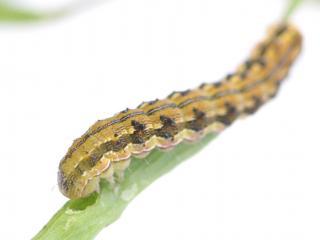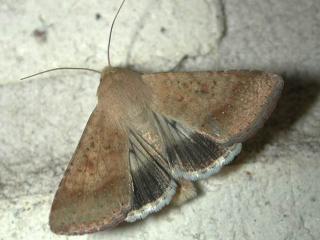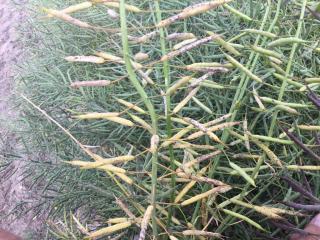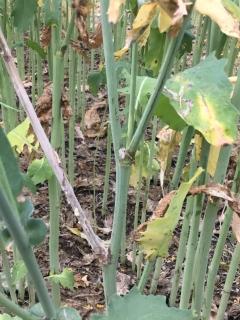Green peach aphids are causing some concern in advanced canola crops
- Central agricultural region
- Great Southern region (including Kojonup)
Brad Joyce (ConsultAg) reports that green peach aphids (GPA) have been moving up onto the stems and pods of podding canola crops in Central and Great Southern areas. He said that the GPA survived sprays which were targeting cabbage and turnip aphids and native budworm caterpillars and the GPA may pose a threat to grain fill if populations get higher. However, Brad noted that crops are not moisture stressed given the recent rainfall.
A grower near Kojonup reports that GPA have been moving up onto the racemes of his podding canola crop.
In advanced canola (flowering onwards), GPA tend to colonise the underside of leaves and are typically not expected to have an impact on yield, even with quite high numbers.
Pests do behave out of character from time to time. Known as the ‘plant stress hypothesis’, there is evidence that plant moisture stress can increase insect activity and performance on affected crops in some circumstances. For example, one study showed that in the brassica plant Arabidopsis thaliana, GPA population growth was higher in drought-affected plants. This was partly attributed to the higher nutritional concentration of sap in plants when moisture-stressed. So, it is quite conceivable that aphids are finding canola stems and pods more attractive than usual.
However, recent rainfall in many areas of the WA grainbelt should work to our advantage in reducing moisture stress of crops still at risk, as well as dislodging aphids from plants and increasing the fungal infection of GPA, which is quite common after rainfall events in spring.
Entomologist Dusty Severtson (DPIRD) has seen GPA colonising canola racemes in dry, warm conditions over the years whilst researching canola aphids. According to Dusty, the worst cases of damage he has seen during spring is when GPA is infesting canola along with turnip and cabbage aphid, and the plants are very moisture-stressed.
It is not known what impact GPA feeding on canola pods will have, and there are no threshold guidelines to guide spray decisions under these conditions.
Canola is more vulnerable to aphid damage at the flowering development stage than at podding, however researchers have seen grain damaged as a result of dense cabbage aphid colonies feeding on pods in moisture-stressed crops. Given this, it cannot be assumed the impact of GPA feeding on stems and pods will be negligible.
If GPA is present in canola paddocks, consider the following:
Beneficials are active
During spring, a suite of beneficials are building in crops and will assist with aphid control. These include, but not limited to; parasitic wasps, ladybird beetles, hoverfly larvae, lacewing larvae, damsel bugs, assassin bugs and spiders. Many beneficial species are highly mobile and will move from crop to crop if left unsprayed. Monitor crops regularly enough so you can measure whether the relative rate of increase in beneficial insects (per sweep, per metre etcetera) is faster (or slower) than that of pest populations. If the former is the case, the beneficials are getting ahead.
With respect to parasitic wasp activity, keep in mind that when an aphid host takes on the typical aphid mummy appearance, wasp development is almost complete. So, the level of parasitism in a crop is higher than what can be seen by eye.
For more information on beneficial insects see DPIRD’s Know what beneficials look like in your crop page and GRDC’s Beneficial insects Back Pocket Guide.
Chemical control options are very limited
Due to insecticide resistance, chemical options for GPA control are very limited in late-stage canola crops. cesar research has found that >90% of all GPA populations collected from canola crops across Australia are highly resistant to synthetic pyrethroids (for example, alpha-cypermethrin) and carbamates (for example, pirimicarb). Applications of these chemicals, even at very high rates, will not control GPA if these resistances are present.
The vast majority of GPA populations also possess resistance to organophosphates (for example, dimethoate). However, the mechanism underlying this resistance is unusual in that it can be ‘switched on’ in response to particular stressors. Additionally, the level of resistance is much lower than for pyrethroids and carbamates. Although risky, this means organophosphates can be effective in some instances. Anecdotal evidence suggests GPA numbers can be reduced by up to 50% despite the presence of organophosphate resistance, although complete control failures have been known to occur (so there are no guarantees!).
Sulfoxaflor (Transform®) is effective against GPA, however it cannot be used on canola past full flower. Paraffinic oils are also registered against GPA in canola, however these sprays will only suppress populations. Oils have the advantage of being soft on beneficial populations and have very short withholding periods.
For more information refer to GRDC’s Resistance management strategy for the green peach aphid in Australian grains .
Who is the main culprit?
If you have large colonies of aphids on canola racemes and have a mix of species, it is important to correctly identify the main culprit. Turnip aphid and cabbage aphid are common on stems and pods during spring and aren’t resistant to registered chemistries. If either of these two species are present and in large numbers, we recommend the use of pirimicarb as it is softer on beneficials. The current threshold for cabbage aphid and turnip aphid is >20% of plants infested with colonies, however the research conducted for this threshold was with growth stages prior to advanced podding, and it is critical to consider several other factors before making a decision. Most importantly, the current growing conditions and moisture availability should be assessed. Crops that are not moisture-stressed have a greater ability to compensate for aphid damage and can tolerate higher infestations than moisture-stressed plants before yield loss occurs.
Aphid numbers will crash naturally
Rain, particularly heavy rainfall events, will impact GPA populations by physically dislodging them from plants. This is more likely where aphids are located on the pods and stems (as opposed to the leaves). Rain can also promote the growth of entomopathogenic fungi which kills aphids.
As the canola seed develops and ripens and pods begin to senesce, they quickly become unfavourable for aphids as they are less able to probe the plant’s tissues. At this time, aphids die out very quickly (or move on to other crops) and management actions are not necessary. Field reports suggest GPA numbers have plummeted in some canola crops in the past week.
For more information on identifying and managing canola aphids refer to the DPIRD’s;
- Aphid management in canola crops page
- Diagnosing canola aphids page
- 2017 Protecting WA Crops Issue 3 newsletter Aphids – WA’s insect problem children
- Aphids in your crops YouTube video.
This article was written in collaboration with cesar.
For more information contact Dustin Severtson, Development Officer, Northam on +61 (0)8 9690 2160 or Julia Severi, Research adoption and extension scientist, cesar on +61 (0)3 9349 4723.
Native budworm moth activity. Trapping has finished for the season
Caterpillar activity
- Moora
- Central agricultural region
- Cunderdin
- Brookton
- Cuballing
- Varley
- Cascade
- Scaddan
Technical officer Dave Nicholson (DPIRD) has found three native budworm caterpillars (15-20 mm long) per 10 sweeps in a lupin crop at Moora. The pods are still very green.
An agronomist has continued to find budworm caterpillars chewing into lupin and canola pods in unsprayed crops across the central agricultural region.
A grower near Cunderdin reports finding above threshold numbers of native budworm caterpillars in their canola, lupin and field pea crops.
A grower near Brookton reports finding significant numbers of native budworm caterpillars in canola crops and serradella pasture recently. The farmer commented that the infestations were the worst they had seen for many years and urged farmers to check their serradella pastures for the presence of native budworm caterpillars.
A farmer north of Cuballing has been sweep netting podding canola and lupin crops and has found between 20-30 native budworm caterpillars per 10 sweeps in both crop types.
A farmer near Varley reports finding five budworm caterpillars per 10 sweeps in a podding field pea crop, a control spray of alphacypermethrin has been applied to reduce grub numbers.
Budworm is posing ongoing issues for growers in the Esperance region with very high numbers found in some canola crops near Cascade and a grower at Scaddan has sprayed his podding field pea crop for budworm this week.
Serradella crops that are to be harvested for seed should be regularly checked for native budworm caterpillars. Caterpillars eat increasing quantities of seed and plant material as they grow with the last two growths stages (fifth and sixth instar 20-40mm) responsible for eating over 90% of their total plant consumption. The final two instars can cause considerable seed yield loss in a very short space of time. Along with serradella, lucerne, clover and annual medic seed crops may also be attacked.
Serradellas are reasonably easy to net if they haven’t been grazed hard. If seed production is important then spray control is required where grubs are found (1-2 grubs per 10 sweeps) whilst the plants have green immature pods.
One well-timed spray of registered rates of synthetic pyrethroid chemical to control native budworm should be sufficient in most situations to kill the caterpillars present.
Native budworm moth surveillance
- Usual automated and manual trapping locations
This week’s larger moth flight captures include; Kojonup (250 moths), Pingrup (180), Cuballing north (162) and Maya east (85).
Results of this week's automated and manual trappings are available at the department’s Native budworm moth numbers 2018.
This was the final week of native budworm moth trapping as any future moth flights and egg laying will not be a threat to crops. The efforts of this season’s volunteer native budworm moth trappers, in sending in weekly reports to PestFax and providing advanced warning of the budworm threat, are greatly appreciated.
All late maturing pulse and oilseed crops should be checked for native budworm, especially in areas where moth numbers have been recorded in the past 3-4 weeks.
A mapped view of the native budworm trap captures is available at cesar’s MothTrapVisWA page. Viewers need to select the desired trapping date range.
For more information on native budworm control refer to DPIRD’s 2018 PestFax Issue 22 article Native budworm moth flights are increasing in numbers and distribution and Management and economic thresholds for native budworm page.
Be mindful of withholding periods near harvest
Farmers with native budworm caterpillars in their crops need to be mindful of insecticide withholding periods (WHP) close to harvest and remember that windrowing is classified as harvest.
For more information on insecticides refer to the department’s Winter/Spring Insecticide Spray Chart 2018.
For more native budworm moth information contact Alan Lord, Technical Officer, South Perth on +61 (0)8 9368 3758 or +61 (0)409 689 468.
For more information on native budworm and serradella contact Angelo Loi, Senior Research Officer, South Perth on +61 (0)8 9368 3907 or +61 (0)429 378 279.
Snails are active in crops down south
- Mount Barker
- Gairdner
- Esperance
As a part of the GRDC funded national project (DAS00160) cameras are being used to record when snails and slugs are active. Trial cameras located at Mount Barker, Gairdner and Esperance are showing snails are actively moving and have been observed climbing up crop stems. Placebo baits placed under cameras show snails are also feeding. At these sites juvenile small pointed snails are still less than 3mm in length.
The trial will continue over summer and it’s hoped that the research team will be able to assess the survival of juvenile snails over summer.
This current snail activity may pose a contamination risk when the crops are harvested.
Entomologist Svetlana Micic (DPIRD) says that as a 'rule of thumb' if snails are easily seen on crop stems grain contamination at harvest is possible.
Snail movement does depend on the species and the weather conditions. Round snails are more likely to be found moving up off hot ground whereas small pointed snails are more likely to burrow underground as weather conditions become warmer.
Research conducted by DPIRD found that snails were more active at night and were active during the day if weather conditions were wet.
There are receival limits for snails in grain delivered to CBH receival sites. For more information refer to CBH’s Receival Standards page.
Snail management options for harvest
At harvest it is the snail infestation in the canopy that causes contamination of grain. If snails are being observed in the canopy consider increasing the cutting height or changing harvest fronts. For instance stripper fronts have been found to decrease snail contamination in grain.
It is difficult to clean machinery before moving from one paddock to the next. Consider harvesting snail infested properties or paddocks last to minimise the risk of introducing snails to new areas.
Management options for 2019
Growers with high numbers of snails in their grain this harvest can take steps to decrease numbers of this pest by having a year-round approach to controlling snails.
Correctly identifying snail species and monitoring numbers prior to harvest and after control operations are important to enable the best management outcomes.
Despite feeding activity being captured on camera recently it is not recommended that growers bait at this time of year as snails are more likely to encounter green plants than baits. Snail baits can be applied after harvest if cool and moist weather occurs to activate snail movement and feeding. But bait only if snails are actively feeding, this can be done by placing baits in patches and observing if dead snails are found adjacent to the baits.
Hot, dry summers do not necessarily kill snails. The small pointed snail can burrow and are readily found in the roots of some plants.
For more information on snail management visit;
- DPIRD’s Identification and control of pest slugs and snails for broadacre crops in WA
- GRDC’s Bash'Em Burn'Em Bait'Em: Integrated snail management in crops and pastures
- Stirlings to Coast Farmers Snail management guide for WA farmers.
For more information contact Svetlana Micic, Research Officer, Albany on +61 (0)8 9892 8591.
Clean augers, field bins and silos prevent insects contaminating grain
The 2018/19 harvest has commenced in WA with the first load of canola delivered to the CBH Geraldton Port Terminal on Tuesday 16 October.
Growers who are yet to commence harvest are reminded that they should check and maintain grain silos before storing this year's harvest to guard against grain storage pests. Regulations prohibit the sale and handling of insect infested grain as well as the spraying of contact insecticides onto grain.
Sealed silos are the preferred system of storage but rubber seals should be checked. Augers, field bins and silos should be thoroughly cleaned of grain residues and treated with a hygiene spray or dust. The ground around storages should be cleared of weeds and rubbish to prevent harboring insects. Old grain resides should be burned or deep buried.
Be aware of withholding periods if you are treating the inside of an empty silo with a suitable insecticide such as fenitrothion, to provide residual control before the grain is loaded. Non-chemical products like Dryacide® dust need at least two weeks to be effective.
Dryacide is an insecticide and will provide good control for at least 12 months. It is a non-toxic, diatomaceous earth product that must be applied when loading the silo at a rate of one kilogram per tonne. This grain can only be used on your own farm since most central grain buyers will not accept it as it changes the flow characteristic of the grain. However you can store grain even in an open shed very safely using Dryacide.
Nitrogen can be used on its own for effective insect control, and can also be coupled with other fumigant delivery systems to apply chemicals such as ethyl formate to dramatically reduce fumigation exposure periods.
The advantages of using nitrogen for managing insects in stored grain are there are no withholding periods, no fumigant residues and no insect-resistance issues. Grain quality is maintained throughout the storage period and, unlike carbon dioxide, nitrogen is not a greenhouse gas.
Growers are reminded that the insecticide fenitrothion is not registered as a seed treatment. Fenitrothion is a contaminant in exported grain. If you are using either liquid or dust in the weeks prior to harvest it is recommended you leave it in place for 2-3 days and then wash it off to prevent contamination of any grain that may come into contact with the sprayed surface. It is better to have applied fenitrothion to an empty silo at least two months before harvest to allow it to degrade to harmless substances.
Phosphine is a very effective fumigant gas for sealed storages but it must be held under gas-tight conditions at a lethal concentration for 7-10 days to kill all insect growth stages. Poor fumigation can result in only adult and larval insects being killed giving the mistaken impression that the fumigation was successful. However, the immature eggs and pupae will not be killed so infestations will likely build up again quickly, selecting for resistant populations. Fumigating in an unsealed silo or field bin is an off label use, it is not only ineffective, at best killing adults and larvae, and will lead to strong resistance developing on your farm.
Managing phosphine resistance
Insect populations with weak phosphine resistance have developed in all grain-growing states of Australia largely as a result of poor fumigations. Strong resistance is widespread in the eastern states and has started to take hold in the west, so to help minimise the development of strong resistance to phosphine in WA, use well maintained sealed silos.
Detecting phosphine resistant grain pests early will make eradication possible and will protect your income. To arrange a free resistance test for grain pests contact David Cousins, DPIRD stored grain insect group, South Perth on +61 (0)8 9368 3920.
Farmers keeping grain on farm for their own use, with silos that are not sealed can use aeration or Dryacide or a combination of both as alternative methods to keep insects in low numbers.
Aeration is a tool for creating a low temperature in the silo so that insects breed very slowly. Insects rely on the environmental temperature for body warmth and breed faster in warm conditions. If the temperature is kept below 20°C they will produce less progeny in the storage period. However to stop reproduction, grain temperatures must be kept below 14°C; temperatures below 10°C (difficult in WA) will eventually kill the insects. Failure to follow these strategies may result in the grain having populations of insects and cannot be sold off-farm without fumigation by transferring it to a fully sealed and tested silo.
For more information on stored grain management techniques visit;
- GRDC supported website; Stored grain information hub
- GRDC’s Hygiene and structural treatments for grain storage factsheet.
- DPIRD’s Sealed silos make sense page
- DPIRD's Insect pests of stored grain page.
For more information contact David Cousins, Technical Officer, South Perth on +61 (0)8 9368 3920.
Alternaria blackspot and sclerotinia stem rot in canola
Alternaria black spot
- Williams
- Esperance
Plant pathologist Ravjit Khangura (DPIRD) reports seeing alternaria black spot in a canola crop near Williams.
Plant pathologist Andrea Hills (DPIRD) reports that alternaria is also present in the Esperance region with small patches of one crop severely affected.
Spots of alternaria on leaves and pods have a concentric or target-like appearance and are brown, black or greyish white with a dark boarder. Lesions on green leaves are often surrounded by a chlorotic (yellow) halo. Lesions on the pods can be in the form of dark spots of varying sizes. Several spots may join to form large lesions. Severe pod infections may cause seed to shrivel and the pods to prematurely ripen and shatter. Stem spots are elongated and almost black.
Pod symptoms of alternaria are similar to those of blackleg and the two can be difficult to distinguish in the field.
Alternaria can be common in canola crops but is not usually severe enough to warrant control.
For information refer to DPIRD’s Diagnosing alternaria black spot in canola page.
Sclerotinia stem rot
- Katanning
- Kojonup
- Kendenup
Plant pathologist Ravjit Khangura (DPIRD) also reports seeing some sclerotinia stem rot in canola near Katanning, Kojonup and Kendenup.
Sclerotinia infection, similar to alternaria, causes premature ripening of plants and therefore poses the risk of premature shattering.
Most of the WA canola crops are at an advanced stage now. Research conducted by DPIRD has shown that there are no economic returns from late fungicide applications (70-80% bloom) and there is a danger of fungicide withholding period concerns.
For further management information refer to DPIRD’s Managing sclerotinia stem rot in canola page.
Look out for sclerotia in harvested seed
Harvest has already begun in the northern region and will soon begin in other regions for canola, lupin and pulse crops and growers are reminded to check their seed for the presence of sclerotinia sclerotia, especially if they are planning to retain their seed for next year’s crop.
Seasonal conditions have been favourable for sclerotinia in canola this season so there is a high probability that the sclerotia may be mixed with the harvested seed in severely affected crops.
Ravjit advises that sclerotia are resting bodies of the fungus that are generally black in color, 2-20mm in length and can survive in soil for more than four years. They are often colourfully described as looking like ‘rat droppings’.
Growers are urged to carefully inspect their harvested seed and if they find large numbers of sclerotia, the seed should be graded. Ungraded seed used for sowing can inadvertently transfer sclerotia into the soil, which can initiate the disease during the season.
CBH delivery standards also have a maximum allowed level for sclerotia of 0.5% or 2.5g in the 500g sample.
Paddocks with a heavy load of sclerotia should be rotated with non-host crops such as cereals for at least for 3-4 years to allow the sclerotia to decompose. Tillage and deep ploughing can also be employed to bury sclerotia to a depth of more than 15cm. Grinding up sclerotia in a weed seed destructor was discussed in last week’s PestFax Issue 25 article Sclerotinia stem rot in lupins. Tips for minimising the impact on harvested grain quality and planning for next season
Strategies for managing sclerotinia stem rot in 2019
These include;
- Long rotations; sow non-host crops (all broadleaf crops can host sclerotinia)
- Avoiding sowing close to last year’s infected crop
- Using clean seed
- Using foliar fungicide.
Further information about managing sclerotinia stem rot can be found at;
- DPIRD’s 2018 PestFax Issue 25 article Sclerotinia stem rot in lupins. Tips for minimising the impact on harvested grain quality and planning for next season
- DPIRD’s Managing sclerotinia stem rot in canola page
- DPIRD’s Protecting WA Crops Issue 5 newsletter Sclerotinia stem rot
- GRDC’s Managing sclerotinia in canola YouTube video.
For more information on canola sclerotinia contact Ravjit Khangura, Plant Pathologist, South Perth on +61 (0)8 9368 3374 or Ciara Beard, Plant Pathologist, Geraldton on +61 (0)8 9956 8504 or Andrea Hills, Plant Pathologist, Esperance on +61 (0)8 9083 1144.
Biosecurity Blitz 2018 starts this weekend
DPIRD is asking for your help to keep an eye out for insects, pests and diseases lurking around the bottom of the garden, in the nearby reserve, out in the veggie patches, fields or splashing around in the local marina.
To participate, make as many pest reports as possible during the Biosecurity Blitz period; 19 October to 2 November 2018 using one of DPIRD's mobile reporting apps.
Your reports will help protect WA’s agri-food industries and the natural environment from harmful exotic pests.
Subscribe to receive the Biosecurity Blitz weekly newsletter and keep up to date by tracking community reports, receive fun news bites and featured activities plus see the best of the best, hand-picked community photos of the prettiest, weirdest and most interesting reports!
For more information visit DPIRD’s Biosecurity Blitz page.
Take up the School Challenge
As part of Biosecurity Blitz 2018, the department is holding its first School Challenge. Any student, in any school, across any region can take part in the school challenge to compete against mates or go head-to-head with a rival school.
Students first need to sign up for the School Challenge and make reports. Students will be able to compare their individual results and their school's results against right across Australia.
We challenge agricultural colleges to take part in one of these focus activities;
- Liver fluking fun
- Dung kings donuts
- Aphids of my eye
For more details on these activities visit the Biosecurity Blitz 2018 activities page.
Schools can also access more information at the Biosecurity Blitz School Challenge 2018 page.
Report a pest today!
The Biosecurity Blitz is part of the Boosting Biosecurity Defences project funded by Royalty for Regions and led by DPIRD.
For more information contact Laura Fagan, Development Officer, South Perth on +61 (0)8 9368 3212.






